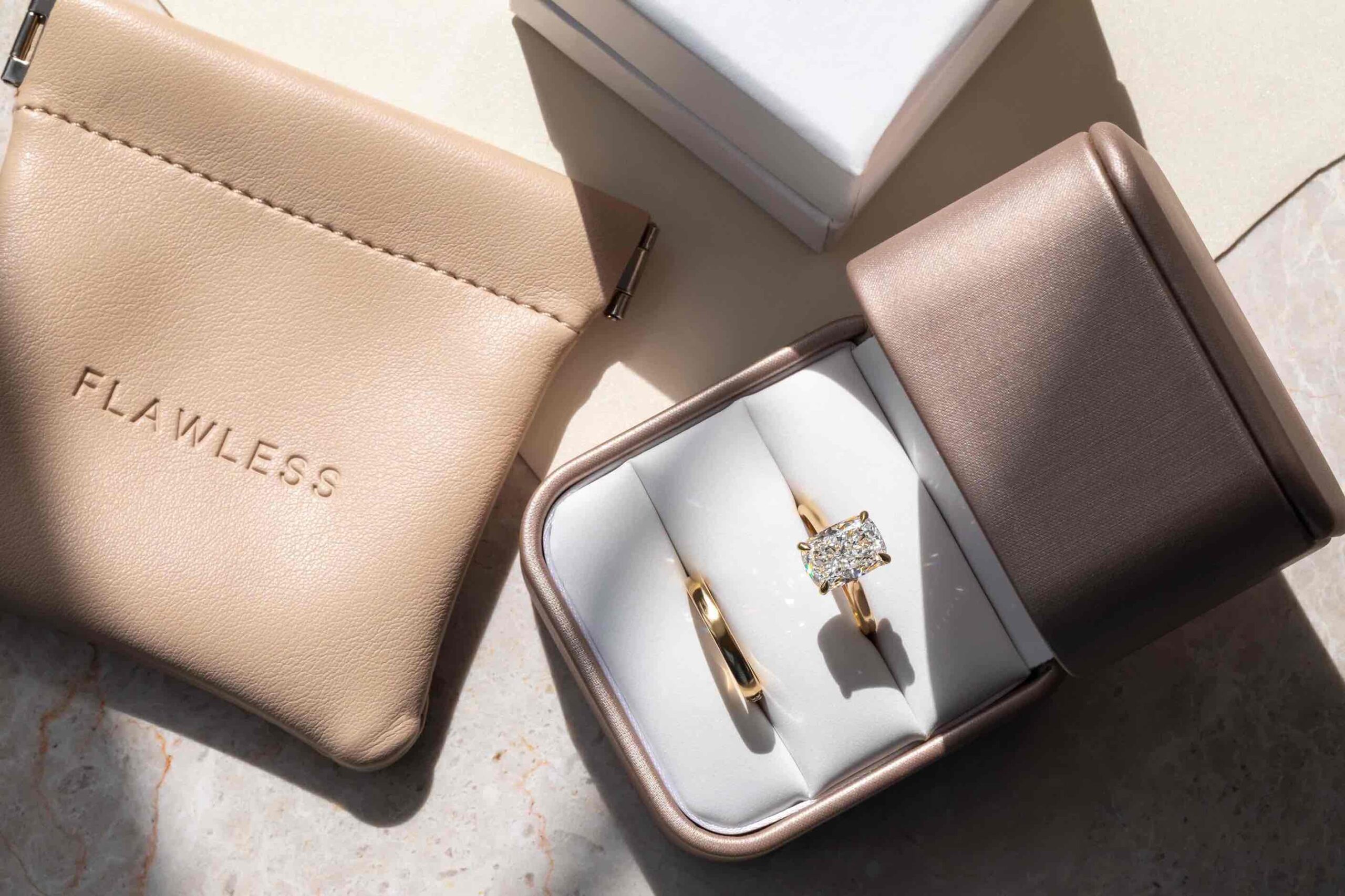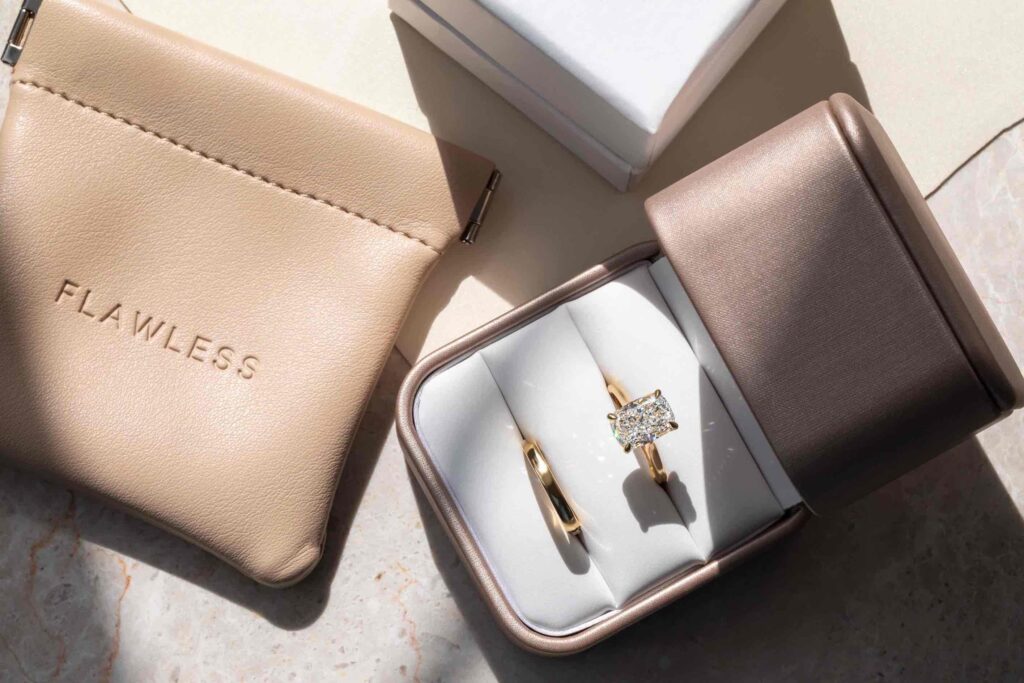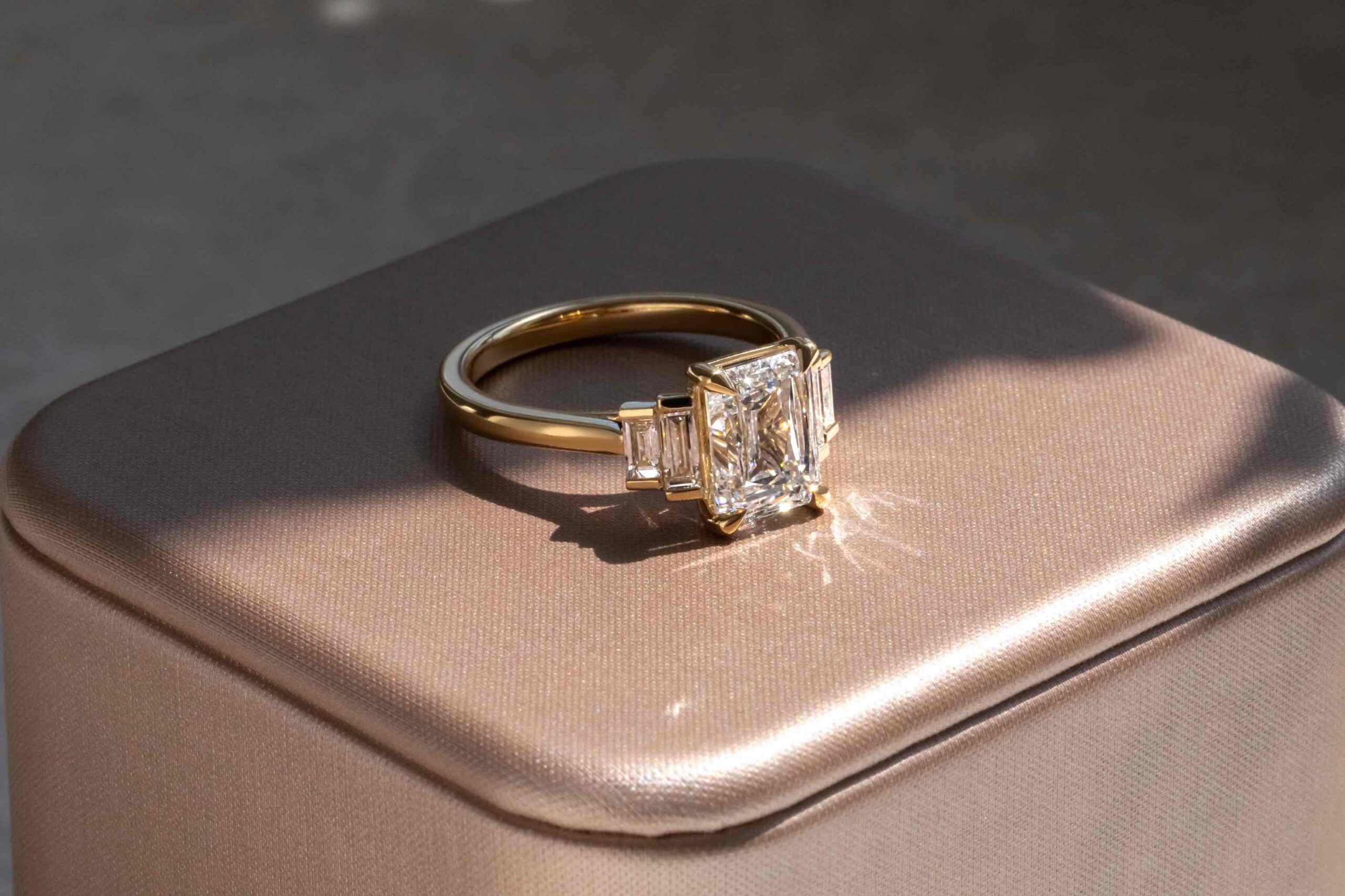
12 Jun 2025 — by Flawless Fine Jewellery — Reading time 12 minutes
The Ultimate Guide to Lab Grown Diamonds: Science, Ethics & Value
The Knowledge You Need To Find Your Perfect Gemstone
Introduction
Lab grown diamonds are transforming luxury in the modern era—blending advanced science with responsible elegance. As transparency and sustainability rise to the top of shoppers’ concerns today, these diamonds provide an incredible, ethically responsible alternative to naturally mined stones. This guide delves into the science behind lab grown diamonds, their ethical pull, and what you should know before making an informed purchase.

Topics covered
- What are Lab Grown Diamonds?
- The Science Behind Lab Grown Diamonds
- Are Lab Grown Diamonds Real Diamonds?
- Why Lab Grown Diamonds?
- Differences Between Lab and Mined Diamonds
- Lab Grown Diamonds vs. Diamond Simulants
- How to Tell if a Diamond is Lab Grown
- Certification, Grading, and Popular Settings
- Myths Surrounding Lab Grown Diamonds
- The Rise of Sustainable Luxury
- Choosing the Perfect Lab Grown Diamond
- Looking after Lab Grown Diamond Jewellery
- Are Lab-Grown Diamonds Suitable for You?
- The Future of Fine Jewellery
- Lab Grown Diamonds: FAQs
What are Lab Grown Diamonds?
Lab diamonds are real diamonds grown in controlled lab environments under laboratory controls using the latest technological processes. Lab diamonds possess identical physical, chemical, and optical properties to diamonds unearthed, and thus they are virtually indistinguishable to the naked eye.
Unlike diamond simulants, such as cubic zirconia or moissanite, lab grown diamonds are made up of carbon atoms that exist in the same crystal form that composes natural diamonds. They are 100% authentic and certified by highly respected gemological labs like IGI and GIA.

The Science Behind Lab Grown Diamonds
Lab grown diamonds are produced using two main techniques: Chemical Vapor Deposition (CVD) and High Pressure High Temperature (HPHT). Both methods mimic the processes occurring naturally that create diamonds deep beneath the earth but in highly controlled laboratory conditions.
When CVD is done, a thin section of diamond seed— usually made of carbon—is placed within a vacuum chamber with carbon-containing gases like methane and hydrogen. These gases are then heated to temperatures ranging from 800–1200°C with the help of microwaves or other sources of energy. The gas molecules are ionised with such immense heat, and carbon atoms settle on the diamond seed. Over time, the atoms stack up layer after layer to create a bigger diamond crystal. One of the main strengths of the CVD technique is that it is precise and controllable, and thus it tends to produce diamonds of excellent clarity and few inclusions.
HPHT is intended to replicate the high pressure and temperature conditions some 150 kilometers beneath the Earth’s surface. Carbon—usually in the form of graphite—is inserted into a capsule containing a diamond seed and subjected to very high pressure (more than 1.5 million pounds per square inch) and temperatures above 1,400°C in a special press. In these conditions, the carbon is melted and starts to crystallize around the seed, creating a diamond. HPHT diamonds are well-known for their high hardness and are frequently utilized not only in jewellery, but also in industrial uses.
Both techniques yield lab grown diamonds that are chemically, physically, and optically the same from natural diamonds.

Are Lab Grown Diamonds Real Diamonds?
Yes, lab grown diamonds are real diamonds.
They are not synthetic diamonds in the way most use the term “synthetic” to mean imitation. Synthetic diamonds is rather just a phrase that refers to diamonds grown in a laboratory rather than mined out of the earth. Their authenticity is verified by trained gemmologists and authorised through certification.
Why Lab Grown Diamonds?
Lab grown diamonds are gaining popularity for a variety of solid reasons:
1. Ethical Sourcing
Lab grown diamonds are an ethical choice in diamonds. They are devoid of human rights concerns surrounding some mined diamonds, such as hazardous working conditions or funding conflict.
2. Sustainable
Mined diamonds come with massive land excavation, water consumption, and carbon emissions. However, lab grown diamonds are produced using sustainable technologies that have minimal environmental impact.
3. Cost-Effective
Lab diamonds are 30–40% more affordable than similar mined diamonds. That means a bigger, brighter gem for the same price.
4. Transparency
Every lab grown diamond is with an open origin. Purchasers have no concept of where and how their diamonds were produced.
Differences Between Lab and Mined Diamonds
Find out the differences below
| Feature | Lab Grown Diamonds | Mined Diamonds |
|---|---|---|
| Environmental Impact | Lower | Higher |
| Ethical Concerns | None | Possible |
| Cost | More affordable | More expensive |
| Appearance | Identical | Identical |
| Traceability | High | Variable |
Lab Grown Diamonds vs. Diamond Simulants
Lab grown diamonds are wrongly taken together with diamond simulants, when in fact the two are quite different in terms of composition and properties. While lab grown diamonds are real diamonds synthesized using advanced technological methods, diamond simulants are other substances altogether that only look like a diamond but lack its fundamental properties.
Simulants like cubic zirconia, moissanite, and white sapphire are among the most popular substitutions employed to match the brilliance of diamonds. They may have brilliance and clarity, but they do not possess the unique chemical makeup of an actual diamond. Cubic zirconia, for instance, is grown from zirconium dioxide and although it may appear dazzling, it’s much softer and more easily scratched and cloudy with age. Moissanite consists of silicon carbide and is nearer a diamond in hardness but still not the same in brilliance, tending to have a fiery, rainbow-colored flash that’s easily differentiated from the light dispersion of a diamond.
By comparison, diamonds created in a laboratory contain precisely the same chemical composition as natural diamonds—carbon atoms in a crystal lattice. They show the same hardness, fire, and resilience. They are cut to the same standards as mined diamonds and only discriminate from them through sophisticated gemmological testing equipment.
This critical distinction is essential for consumers seeking a diamond’s authenticity, longevity, and prestige. Choosing a lab grown diamond ensures you’re getting a genuine diamond, not just a look-alike. While simulants may offer temporary sparkle, only lab grown diamonds deliver the full value and performance of the real thing.
How to Tell if a Diamond is Lab Grown
Lab grown diamond detection is significant, especially to trade professionals and retailers. While physical inspection alone is not reliable, gemmologists take advantage of advanced equipment and testing methods to determine lab-grown diamonds from earth-mined ones.
Identification methods are most crucial in that:
– Laser inscriptions: Most lab-grown diamonds are laser-inscribed on the girdle with an origin and serial number. Therefore, it is essential to examine the girdle of the diamond.
– Spectroscopic analysis: Specialized equipment can identify tracing elements and growth patterns unique to lab grown diamonds.
– Inclusion patterns: Lab diamonds, when examined under magnification, will exhibit metallic inclusions or growth lines that are unique compared to mined diamonds.
– Diamond Certification: All authentic lab grown diamonds contain certificates indicating their origin and mode of creation.
Certification, Grading, and Popular Settings
Lab grown diamonds are graded based on the same strict criteria as natural diamonds. They are graded according to the globally accepted 4Cs: Cut, Colour, Clarity, and weight of Carat. These characteristics establish a diamond’s general quality and brilliance. For transparency and genuineness, well-known gemmological organizations like the Gemmological Institute of America (GIA) and the International Gemmological Institute (IGI) provide grading reports for lab grown diamonds. Such certificates authenticate the specifications of the diamond and clearly state whether the diamond is lab grown or earth mined. When buying a lab grown diamond, it is important to ask for a grading certificate since it provides quality assurance and facilitates making an informed purchasing decision.
Lab grown diamonds are as durable as mined diamonds, with a Mohs hardness of 10. They are scratch-resistant, chip-resistant, and suitable for wear on a daily basis. These can be used in engagement rings and other forms of fine jewellery. Aside from rings, they are also used for tennis bracelets, pendant necklaces, and traditional stud earrings. Since lab grown diamonds tend to be more budget-friendly, consumers usually prefer larger carat weights or more complex settings without overspending. This versatility provides consumers with the ability to indulge in luxury and value when choosing a piece that also expresses their own personal style.

Myths Surrounding Lab Grown Diamonds
Let’s debunk some common myths:
Myth: Lab grown diamonds are fake.
Truth: They are chemical and optical genuine diamonds.
Myth: Lab diamonds are inferior.
Truth: Lab grown diamonds tend to be higher in colour and clarity due to controlled processes.
Myth: Mined diamonds are the only ones of worth.
Truth: Lab grown diamonds offer value in terms of sustainability, size, and beauty.
The Rise of Sustainable Luxury
Currently, consumers are growing more conscious of the impact their purchases have on society and the wider planet. As a result, lab-grown diamonds are becoming very popular in the fine jewellery industry. They align with the ideals of sustainability and ethical responsibility, but they still have all the brilliance and fire of diamonds.
Hyped as eco-friendly diamonds, sustainable diamonds, or conflict-free diamonds, lab grown diamonds sidestep social and environmental issues associated with conventional mining. Their manufacture has a much lighter carbon footprint and does not pose a risk of promoting exploitative labor conditions or financing conflict. Through the purchase of lab grown diamonds, consumers help bring forward responsible innovation and promote a cleaner, more responsible luxury goods future.
Choosing the Perfect Lab Grown Diamond
When choosing a lab grown diamond, you should begin with your budget. Since these diamonds are less expensive than their natural counterparts, you should be able to afford a larger stone or a more quality cut without making a huge dent in your wallet. This is how you can make beauty and brilliance your top priority within an affordable range.
Next, consider the shape of the diamond that best suits your personal style. Whether it’s a timeless round cut, a striking princess cut, or a vintage-inspired emerald or cushion cut, each shape brings a unique character to the piece.
Certification is also a priority. Always have your diamond graded by a reliable gemmological laboratory like GIA or IGI. Not only does this ensure the quality of your diamond, but it also confirms that its lab grown, giving you comfort with your investment.
Looking after Lab Grown Diamond Jewellery
Lab diamonds are very resilient, but as with any high-quality jewellery, they respond well to frequent care in order to keep them shining and in good condition. Cleaning your diamond jewellery at home is easy. A soft-bristled brush and warm water with a gentle soap is generally sufficient to clean away day-to-day grime and oils.
Remove your jewellery when working with concentrated household cleaners like bleach or chlorine because they can weaken and damage metal settings over time. Store your lab grown diamond jewellery pieces separately from one another in a jewellery box lined with fabric or a soft pouch to prevent scratching.
Finally, regular check-ins with qualified jewellers like Flawless Fine Jewelry, one of the best Hatton Garden Jewellers are advisable. Prongs and settings can loosen with wear over time, so a brief inspection guarantees that your diamond will stay secure and in good shape. If well cared for, lab grown diamond jewellery can look lovely for generations.

Are Lab-Grown Diamonds Suitable for You?
If you care about sustainability, transparency, and affordability with no sacrifice of beauty, lab grown diamonds are the perfect option.
Whether purchasing an engagement ring or rewarding yourself with high-quality jewellery, lab grown diamonds offer timelessness and assurance.
The Future of Fine Jewellery
Lab grown diamonds aren’t merely a fad—they’re a revolutionary transformation within the fine jewellery world. The more conscious and values-based consumers become, the greater the demand for sustainable and responsibly sourced alternatives will remain. Lab grown diamonds provide an unprecedented mix of science, beauty, and conscience. Physically, chemically, and optically indistinguishable from mined diamonds, they arrive without the environmental and ethical issues associated with conventional diamond mining.
Their affordability also provides consumers with increased freedom—be that opting for a heavier carat weight, a luxury cut, or a more intricate setting. More significantly, the use of lab grown diamonds is a deliberate choice to adopt innovation and sustainability without sacrificing sophistication or quality.
For the contemporary, conscious consumer, lab grown diamonds are the ultimate expression of luxury with a purpose. They provide the fire of yesteryear, reimagined for a brighter, better future.
“Explore our collection of certified lab grown diamonds and find a piece that reflects your brilliance — inside and out.”
Lab Grown Diamonds: FAQs
Are lab grown diamonds real diamonds?
Yes, lab grown diamonds are real diamonds synthesized using advanced technological methods, diamond simulants are other substances altogether that only look like a diamond but lack its fundamental properties.
How are lab grown diamonds created?
Lab created diamonds are produced employing two main techniques: Chemical Vapor Deposition (CVD) and High Pressure High Temperature (HPHT). Both methods mimic the processes occurring naturally that create diamonds deep under the earth but in highly controlled laboratory conditions.
Are lab grown diamonds durable?
Lab created diamonds are as durable as mined diamonds, with a Mohs hardness of 10. They are scratch-resistant, chip-resistant, and suitable for wear on a daily basis.
How can you tell if a diamond is lab grown?
Most lab-grown diamonds are laser-inscribed on the girdle with an origin and serial number. Specialized equipment can identify tracing elements and growth patterns unique to lab grown diamonds. Lab diamonds, when examined under magnification, will exhibit metallic inclusions or growth lines that are unique compared to mined diamonds.
